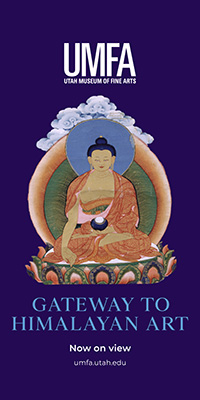
Andrew Rice prepares the walls of his studio-turned-gallery space at Poor Yorick Studios, sanding and patching in preparation for the next exhibition at Erosion Gallery.
For most artists at Poor Yorick Studios, the semi-annual open studio event (see here) may be the only time they put their space in order—some tidying, sweeping, patching, maybe a coat of paint. But just days after welcoming the September crowds, Andrew Rice is once again cleaning up. Gone are the delicate, filigreed collages—small works built from comic book fragments and pop-cultural residue—that he exhibited most recently at Finch Lane Gallery and then at Poor Yorick. He’s sanding, patching, prepping. But the next show belongs to Holly Rios.
Rice is a Utah-based artist, printmaker and educator whose work has long explored the psychological and spatial tensions between interior and exterior worlds. Over the past decade, he has shifted from large, existential drawings of uninhabited rooms—vast blackened spaces that seemed to swallow the viewer—to precise collages loaded with fragments of memory and meaning. During that time, he has turned his attention to building spaces rather than just picturing them. In 2019, with fellow artists Henry Becker and Nolan Flynn, he co-founded The Open Room—a backyard gallery and conversation series that sought to bridge what they saw as a growing divide between artists and audiences. Each event paired an exhibition with shared food, drink and critical dialogue. “The openings functioned a bit different from the typical art show format,” the organizers said at the time. “Instead of people filtering through, it was a small, committed group, all part of a conversation.” The project’s last hurrah was at UMOCA in July 2020, just as the pandemic forced many artists to rethink how—and where—art could be shown. “It was the end of the world,” Rice recalls, “so it seemed like a natural end to the experiment.”
But Rice’s impulse to create spaces didn’t end there. After scaling down his own studio work and dismantling large pieces, he was left with a pile of scrap lumber. “I stopped working large scale, and I had all this leftover wood, so I decided to build storage in my studio,” he says. “When I did that, it created this little nook—almost accidentally—a defacto exhibition space. I put up some drywall, painted it white, and when I saw it all together on the wall, it made sense.”

View of Andrew Rice’s studio at Poor Yorick Studios, showing the compact Erosion Gallery space nestled beside storage shelves and work tables.
The first show at Erosion Gallery, Adam Montoya’s layered photographic prints, monument:resident:alien, went up quietly in 2021. Since then, Erosion Gallery has hosted eight exhibitions, each one intimate, low-stakes and rooted in conversation. “It’s designed for experimental work,” Rice says. “Something you might not be ready to show in a formal gallery. Maybe it’s new, maybe it’s not finished.”
The events are small—often just the artist and a circle of friends—but the talk runs deep. “When you keep going with the same group of people, the dialogue grows beyond a surface level. It’s an ongoing conversation.” (That being said, Rice stresses that everyone is invited to join that conversation).
That spirit made Erosion Gallery a perfect fit for artist and printmaker Holly Rios, who has been itching to curate more work. Like Rice, Rios studied printmaking at the University of Utah. Her work explores domesticity, gender construction and media literacy. For this exhibition, Touch Grass, she has gathered a group of artists whose practices reconnect art-making with place. “Motivated by the overwhelming influx of AI-generated art, the depletion of environmental resources, and political attacks on public land,” Rios explains, “Touch Grass highlights artists who continue to work in traditional media and celebrate their love of our public lands.”

A detail from Nathanael Read’s altered book, part of Touch Grass at Erosion Gallery, combining ink drawings of Utah’s Wasatch Mountains and urban skyline with layered maps and found pages.
The exhibition brings together artists exploring different dimensions of the contemporary West: Matt Jones and Nathanael Read probe the myths and ideologies that shape regional identity; Cy Whitling, a comic artist and illustrator, reflects on outdoor recreation and its visual subcultures; Brooklyn Johnson and Tara Aguirre transform memory and personal experience into tactile records of time spent outdoors.
“On the surface,” Rios says, “the work seems kind of fun and outdoor-rec subculture-y. But there’s a lot of heaviness (political, religious, experiential) couched in the work. Some of it is more foregrounded, like in Cy’s or Nathanael’s work, but the others have that heaviness buried in it in quiet ways.”
In a space barely large enough to fit a handful of people, these layered works feel close, personal. Visitors stand shoulder-to-shoulder, tracing lines, reading text, trading thoughts. That intimacy is the point. “It’s small,” Rios says, “but I really just want to feel some community right now. This curation felt like a way to invite that.”
Rice seems to agree. Whether in his early drawings of empty rooms or his recent collages of fragmented media, his art has always probed the boundaries between connection and separation. With The Open Room and now Erosion Gallery, he has turned those inquiries outward, into real rooms, real communities. In a time when cultural spaces can sometimes feel vast, digital and depersonalized, Rice’s “tiny white cube” suggests art need not be monumental to be meaningful. Sometimes, a few square feet and a few good conversations are enough.

Andrew Rice and curator Holly Rios stand in Erosion Gallery at Poor Yorick Studios as they hang works for Rios’ exhibit Touch Grass, including prints, drawings, and sculptural pieces.
Touch Grass, Erosion Gallery, South Salt Lake, October 3, 6-9 pm.

The founder of Artists of Utah and editor of its online magazine, 15 Bytes, Shawn Rossiter has undergraduate degrees in English, French and Italian Literature and studied Comparative Literature in graduate school before pursuing a career in art.
Categories: Exhibition Reviews | Gallery Spotlights | Visual Arts









